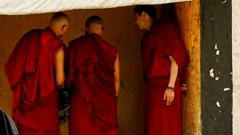In the remote region of Aba, Sichuan province, the Kirti monastery stands as a symbol of Tibetan resilience against the long shadow of Chinese governance. As the Dalai Lama marks his 90th birthday, the atmosphere in Tibet remains tense, heavily monitored by a myriad of security forces. Monks silently navigate their daily prayers and rituals under the watchful eyes of surveillance cameras and government officials.
A monk, cloaked in crimson robes and clutching prayer beads, warned, “Things here are not good for us” while subtly acknowledging the threats posed by state agents trailing our presence. The Kirti monastery gained notoriety as the epicenter of protests where many Tibetans resorted to self-immolation as a form of dissent against Beijing's policies, an act reflecting profound desperation.
Since the Chinese government’s annexation of Tibet in 1950, control has tightened ostensibly in the name of development, yet economic progress has coincided with increased restrictions on freedom and cultural expression. Non-disclosure of the Dalai Lama's narrative is typical, as any public support for him could lead to severe repercussions. Many Tibetans now live in a delicate balance between maintaining their traditions and yielding to governmental mandates that stifle their cultural identity.
Reports confirm that Tibetans are now compelled to send their children to Chinese state-run schools, dampening their exposure to their own language and Buddhist teachings until the age of 18, establishing a pathway towards the erasure of Tibetan customs. Scholars argue that this educational reform is a fundamental threat to Tibetan Buddhism itself, effectively isolating the community from its rich heritage.
The dilemma posed by the Dalai Lama's future succession is also coming into focus. His declaration about choosing his successor has ignited cautious optimism among Tibetan exiles, yet despair among those still under Chinese rule, where mere mention of his name is met with swift suppression. The Chinese Communist Party has strategized to position their approval upon the next Dalai Lama, stirring fears of a divide among the Tibetan people on the legitimacy of leadership.
Tibetans have continuously fought to hold on to their identity for 75 years, even as their way of life and spiritual guidance are progressively eroded by an unyielding regime. In this time of uncertainty, the voice of the monks resonates with resilience amidst the daunting reality; the future of Tibetans remains a battle of existence and preservation against encroaching forces determined at their cultural extinction.




















